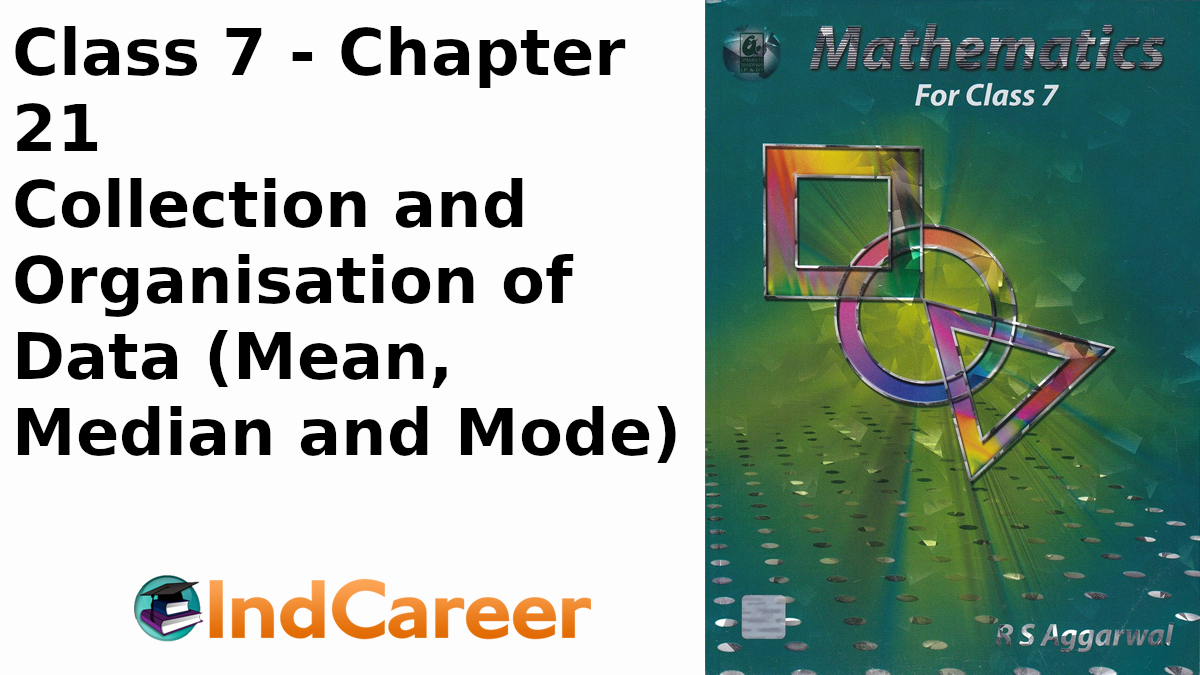Class 7: Maths Chapter 21 solutions. Complete Class 7 Maths Chapter 21 Notes.
Contents
RS Aggarwal Solutions for Class 7 Maths Chapter 21–Collection and Organisation of Data (Mean, Median and Mode)
RS Aggarwal 7th Maths Chapter 21, Class 7 Maths Chapter 21 solutions
Ex 21A Solutions
Question 1.
Solution:
(i) Data : A collection of numerical figures giving some particular type of information is called data
(ii) Raw data : Data obtained in the original form is called raw data.
(iii) Array : Arranging the numerical figures of a data in ascending or descending order is called an array.
(iv) Tabulation of data : Arranging the data in a systematic form in the form of a table is called tabulation of the data.
(v) Observations : Each numerical figure in a data is called an observation.
(vi) Frequency of an observation : The number of times a particular observation occurs is called its frequency.
(vii) Statistics : It is the subject that deals with the collection presentation analysis and interpretation of numerical data.
Question 2.
Solution:
Arranging the given data in ascending order is as given below :
1, 1, 2, 2, 2, 2, 2, 3, 4, 4, 4, 4, 5, 5, 5, 5, 5, 5, 6, 6 and 6 its frequency table will be as under:

Question 3.
Solution:
Arranging the given data in ascending order,
260, 260, 300, 300, 300, 300, 360, 360, 360, 360, 360, 360, 400, 400, 400.
and its frequency table will be as under.

Question 4.
Solution:
Arranging the given data in ascending order we find
5, 5, 6, 6, 6, 6, 7, 7, 7, 7, 7, 7, 7, 8, 8, 8, 8, 8, 9, 9, 10, 10 and its frequency table will be as under.

Question 5.
Solution:
(i) Data means information in the form of numerical figures.
(ii) Data obtained in the original form is called raw data.
(iii) Arranging the numerical figures in ascending or descending order is called an array.
(iv) The number of times a particular observation occurs is called its frequency.
(v) Arranging the data in the form of a table is called tabulation of data.
Question 6.
Solution:
First five natural numbers are 1, 2, 3, 4, 5

Question 7.
Solution:
First six odd natural numbers are 1, 3, 5, 7, 9, 11

Question 8.
Solution:
First seven even natural numbers are 2, 4, 6, 8, 10, 12, 14

Question 9.
Solution:
First five prime numbers are 2, 3, 5, 7, 11

Question 10.
Solution:
First six multiples of 5 are 5, 10, 15, 20, 25, 30

Question 11.
Solution:
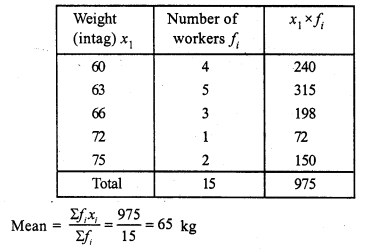
Question 12.
Solution:

Mean = Rs. 159
Question 13.
Solution:
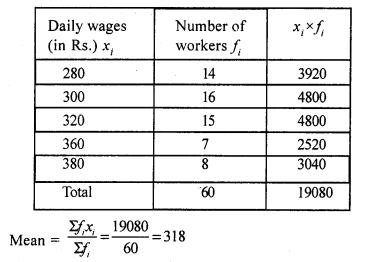
Mean = Rs. 318
Question 14.
Solution:
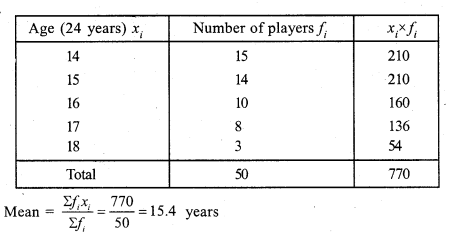
Question 15.
Solution:


Ex 21B Solutions
Question 1.
Solution:
(i) Arranging in ascending order.
2, 2, 3, 5, 7, 9, 9, 10, 11
Here number of terms = 9 which is odd
Median= n+12 = 9+12 th term
= 5th term = 7
Hence median = 7
(ii) Arranging in ascending order,
6, 8, 9, 15, 16, 18, 21, 22, 25
Here, number of terms (n) = 9 which is odd
Median= n+12 = 9+12 th term
= 5th term = 16
(iii) Arranging in ascending order,
6, 8, 9, 13, 15, 16, 18, 20, 21, 22, 25 Here number of terms (n) = 11 which is odd
Median= n+12 = 11+12 th term
= 6th term = 16
Question 2.
Solution:
(i) Arranging in ascending order,
9, 10, 17, 19, 21, 22, 32, 35
Here, number of terms = 8 which is even


Question 3.
Solution:
First 15 odd numbers are 1, 3, 5, 7, 9, 11, 13, 15, 17, 19, 21, 23, 25, 27, 29.
Here, number of terms (n) = 15 which is odd
Median = n+12 = 15+12 th term
= 8th term = 15
Question 4.
Solution:
First 10 even numbers are 2, 4, 6, 8, 10, 12, 14, 16, 18, 20
Here, number of terms = 10 which is even
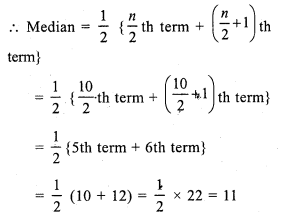
Question 5.
Solution:
First 50 whole numbers
0, 1, 2, 3, 4, …, 49
Here, number of terms = 50, which is even

Question 6.
Solution:
Arranging in ascending order,
17, 17, 19, 19, 20, 21, 22, 23, 24, 25, 26, 29, 31, 35, 40 .
Here, number of terms = 15 which is odd
Median = n+12 th term = 15+12 = 162 th
= 8th term = 23
Question 7.
Solution:
Arranging is ascending order,
31, 34, 36, 37, 40, 43, 46, 50, 52, 53
Here, number of terms = 10, which is even

Question 8.
Solution:
Preparing the cumulative frequency table
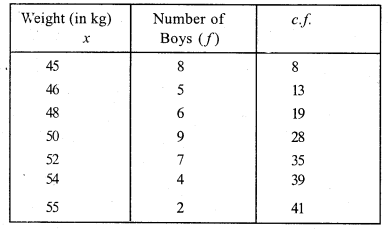
Here, number of terms (N) = 41, which is odd
Median = n+12 th term
= 41+12 = 422 th = 21 th term = 50kg (value of 20 to 28 = 50)
Hence median = 50kg
Question 9.
Solution:
Arranging in order and preparing the cumulative frequency table.
Here, number of terms (N) = 37 which is odd.
Median = n+12 th term
= 37+12 = 382 th term
= 19th term = 22 (Value of 18 to 21 = 22)
Hence median = 22
Question 10.
Solution:
Arranging in order and then preparing its cumulative frequency table :
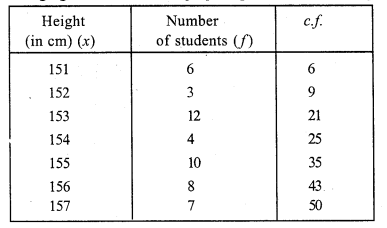
Here, number of terms (N) = 50, which is even

Hence median = 154.5 cm
Ex 21C Solutions
Question 1.
Solution:
(i) Arranging in ascending order :
4, 6, 7, 8, 8, 8, 8, 10, 11, 15
We see that 8 occurs maximum times
Mode = 8
(ii) Arranging in ascending order :
18, 21, 23, 27, 27, 27, 27, 27, 36, 39, 40
We see that 27 occurs maximum times
Mode = 27
Question 2.
Solution:
Arranging in ascending order :
28, 31, 32, 32, 32, 32, 34, 36, 38, 40, 41.
We see that 32 occurs maximum times
Mode = 32 years
Question 3.
Solution:
We prepare the table as given below:

Here, number of terms = 45, which is odd
Median = n+12 th term = 45+12 = 462 th term
= 23th term = 450
Now, mode = 3(median) – 2(mean)
= 3 x 450 – 2 x 470
= 1350 – 940
= 410
Question 4.
Solution:
We prepare the table as given below:
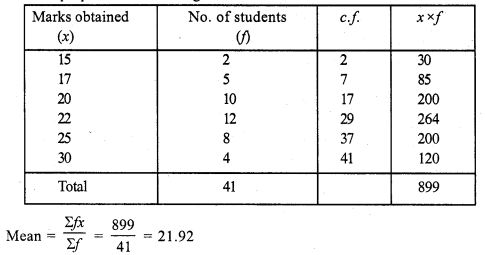
Here, number of terms (N) = 41, which is odd
Median = n+12 th term = 41+12 th term
= 422 = 21 th term = 22 {value of 18 to 29 = 22}
Mode = 3 (median) – 2 (mean)
= 3 x 22 – 2 x 21.92 = 66 – 43.84 = 22.16
Question 5.
Solution:
We prepare the table as given below:

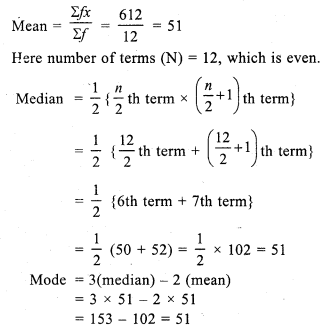
RS Aggarwal Solutions for Class 7 Maths Chapter 1: Download PDF
RS Aggarwal Solutions for Class 7 Maths Chapter 1–Integers
Download PDF: RS Aggarwal Solutions for Class 7 Maths Chapter 1–Integers PDF
Chapterwise RS Aggarwal Solutions for Class 7 Maths :
- Chapter 1–Integers
- Chapter 2–Fractions
- Chapter 3–Decimals
- Chapter 4–Rational Numbers
- Chapter 5–Exponents
- Chapter 6–Algebraic Expressions
- Chapter 7–Linear Equations in One Variable
- Chapter 8–Ratio and Proportion
- Chapter 9–Unitary Method
- Chapter 10–Percentage
- Chapter 11–Profit and Loss
- Chapter 12–Simple Interest
- Chapter 13–Lines and Angles
- Chapter 14–Properties of Parallel Lines
- Chapter 15–Properties of Triangles
- Chapter 16–Congruence
- Chapter 17–Constructions
- Chapter 18–Reflection and Rotational Symmetry
- Chapter 19–Three-Dimensional Shapes
- Chapter 20–Mensuration
- Chapter 21–Collection and Organisation of Data (Mean, Median and Mode)
- Chapter 22–Bar Graphs
- Chapter 23–Probability
About RS Aggarwal Class 7 Book
Investing in an R.S. Aggarwal book will never be of waste since you can use the book to prepare for various competitive exams as well. RS Aggarwal is one of the most prominent books with an endless number of problems. R.S. Aggarwal’s book very neatly explains every derivation, formula, and question in a very consolidated manner. It has tonnes of examples, practice questions, and solutions even for the NCERT questions.
He was born on January 2, 1946 in a village of Delhi. He graduated from Kirori Mal College, University of Delhi. After completing his M.Sc. in Mathematics in 1969, he joined N.A.S. College, Meerut, as a lecturer. In 1976, he was awarded a fellowship for 3 years and joined the University of Delhi for his Ph.D. Thereafter, he was promoted as a reader in N.A.S. College, Meerut. In 1999, he joined M.M.H. College, Ghaziabad, as a reader and took voluntary retirement in 2003. He has authored more than 75 titles ranging from Nursery to M. Sc. He has also written books for competitive examinations right from the clerical grade to the I.A.S. level.
FAQs
Why must I refer to the RS Aggarwal textbook?
RS Aggarwal is one of the most important reference books for high school grades and is recommended to every high school student. The book covers every single topic in detail. It goes in-depth and covers every single aspect of all the mathematics topics and covers both theory and problem-solving. The book is true of great help for every high school student. Solving a majority of the questions from the book can help a lot in understanding topics in detail and in a manner that is very simple to understand. Hence, as a high school student, you must definitely dwell your hands on RS Aggarwal!
Why should you refer to RS Aggarwal textbook solutions on Indcareer?
RS Aggarwal is a book that contains a few of the hardest questions of high school mathematics. Solving them and teaching students how to solve questions of such high difficulty is not the job of any neophyte. For solving such difficult questions and more importantly, teaching the problem-solving methodology to students, an expert teacher is mandatory!
Does IndCareer cover RS Aggarwal Textbook solutions for Class 6-12?
RS Aggarwal is available for grades 6 to 12 and hence our expert teachers have formulated detailed solutions for all the questions of each edition of the textbook. On our website, you’ll be able to find solutions to the RS Aggarwal textbook right from Class 6 to Class 12. You can head to the website and download these solutions for free. All the solutions are available in PDF format and are free to download!
